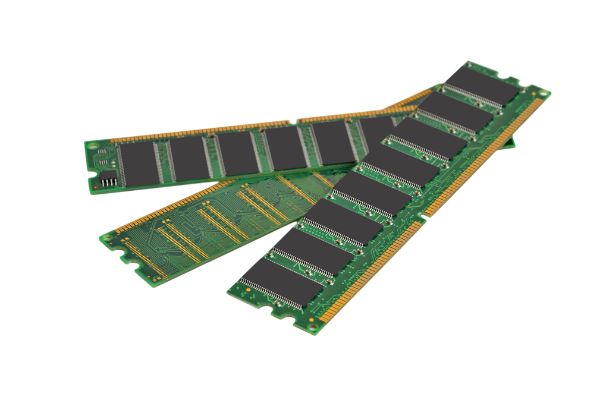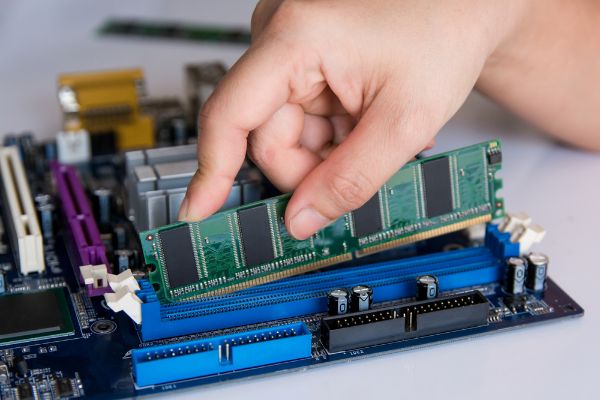Disclaimer: This post may contain affiliate links, meaning we get a small commission if you make a purchase through our links, at no cost to you. For more information, please visit our Disclaimer Page.
RAM is the typical way that most technical experts and computer users will refer to random-access memory. This type of memory moves data from the hard drive and stores it so that the computer’s central processor can access it more quickly. In this way, the computer is able to perform some functions and run some processes faster. This all translates into less wait time for you as the user, and you should see more smoothness and stability in heavy programs like modern games.
If you’ve never looked inside of a computer, it may be tempting to think of RAM memory as just digital signals. However, random-access memory is actually something that manufacturer’s put on physical chips. Once done, these chips attach to longer RAM sticks that you can put inside your PC. Some people wonder if it is easy to break a memory storage unit like this.
We will go over that question in today’s article, and we will look deeper into specific things that might cause damage to RAM as we do. Additionally, we’ll cover the possible physical effects of dropping RAM, whether it is easy to damage it just by touching it, and some of the general guides that might indicate that your RAM is moving into a state of failure. Finally, we’ll wrap things up by giving you some tips on how you might test your random-access memory.
Table of Contents
Does a RAM Stick Break Easily?
Typically, physical RAM is quite robust for a set of chips. If you install and seat the RAM properly, there should be very little chance that it breaks.
To be clear, we are distinguishing breaking the physical random-access memory stick from some other type of failure.
In the latter case, the stick itself may look and seem undamaged, but the RAM on the chips may not be performing well. There could be various reasons for this, and we will cover some of these case scenarios in a later section.
In order to help you see how strong RAM is, we should talk about how most computer parts break. Aside from physical damage due to hitting or dropping a computer, most other components fail when they burn themselves out through many years of use.
As a computer powers and uses its parts, electricity flows through everything to give the rig the energy that it needs.
Most manufacturers rate their parts to last a minimum number of years under normal use. Many of these same components can last for quite a few years beyond this point, too. However, some old parts may fail, and they often spend too much time in use as the delicate pieces inside them wear out.
When this happens, computer users may need to replace these items as a way to fix their problems, even if they don’t appear to have any physical damage.
Random-access memory operates along these same lines, but in a slightly different way. The energy that needs to run through the RAM is much lower than it is for many of the other parts you’ll find inside a computer. Because of this, the failure rate tends to be the highest during the first few months of use.
This is particularly true for new RAM that a developer manufactures and brings to market. After these few months go by, the odds of a problem with your RAM are much lower than those same odds for other parts.
With so little energy necessary in order for RAM to do its job, the chances of actually burning it out are also lower. In fact, you’ll probably want to replace the RAM to make your memory faster before the current chips start to burn out.
Can Dropping RAM Break It?
Technically, there is always a possibility that you could damage your RAM if you drop it. This is just part of the nature of physics, but it should take quite a bit of force for any damage to occur.
If the RAM slips out of your hand, it is not very likely that it will take damage that is significant enough for it to stop working. There are no moving parts on RAM that could break off, and that means there is less chance of something happening that makes the random-access memory unusable to you.
Should you happen to be concerned, you can still do a visual inspection of your RAM stick. If it was in a package when you dropped it, there is almost no way contact with the floor should have given it any damage.
Furthermore, you can look for any chips, cracks, or minor breaks that you think weren’t there before. If part of the stick has a crack running along it, it may not be able to work correctly. If you see nothing, you can at least seat the RAM in your computer and see if it registers when you boot things up for a test.
Can You Damage RAM by Touching It?
As with the previous answer, it is possible, but not very likely. There are still some caveats to consider, however. RAM sticks contain parts that are susceptible to burns through static electricity. This is true for most computer components you will handle.
It is important to make sure that you ground yourself and wear a special wrist strap that diffuses static electricity before you start working with random-access memory or other parts you want to install.
Part of your RAM will have golden points along it, and these are where it makes the connections it uses to transfer data once you seat it inside the computer and start everything.
In theory, if these contact points take any damage from finger oils, debris, static, or other things, there is a chance that you could destroy the RAM module itself. Because this is a possibility, we recommend that you do your best not to touch the gold connector points with your hands.
That said, it is possible that even touching here may not result in any issues for you. If you are concerned, you can hook things up to see what works. If there is a problem with the RAM because of your contact with the pins, or any other point, you will notice it shortly after you start your system.
You may deal with some program crashes or memory errors, and these could be signs that the random-access memory modules you installed have some problems. However, there could be other culprits, so it is not a given that the RAM is at fault.
What Are Some Symptoms of Failing RAM?
As powerful as it is, random-access memory can start to fail over a long time. Sometimes there is a clear reason for this happening, but you may deal with old RAM that starts to lose its ability to transfer data.
In any case, it is good to know what to look for to see if your own modules might be approaching a state of failure. Although our list isn’t comprehensive, here are some of the main signs you can look for when it comes to failing RAM:
1. Your computer will convert to a Blue Screen, which shows a big flaw in the system. Generally, the computer will need to restart or shut itself off. When it does, you may face a BSoD.
During this time, the computer wants to perform a test on itself and all of its files as a way to check for problems and recover some of its memory.
2. Alternatively, your computer may shut down completely when you’re in the middle of an application. Most times, you’ll face the BSoD when you reboot from one of these events.
3. Even if your computer doesn’t shut down, it may slow down to a crawl when you are performing certain actions or using particular applications. This sluggish performance could also indicate a problem with the RAM.
4. Similarly, any random freezing that your computer does could mean that the memory is having trouble keeping up with things.
How Can I Test My RAM?
Many people want to be as sure as possible that random-access memory is not the cause of their woes, and there are ways you can test for this. The single most efficient way to do this is to use a memory test application. Developers design these programs specifically to look for any errors in your computer’s memory.
Some operating systems, like Windows, will come with their own Memory Diagnostic app that you can use to scan the system. There are other third-party apps out there, and they may include features you would like to have, but they should function the same way.
Some programs don’t require a reboot, but others might. In any case, you just need to pick the application you prefer, start it, and let it run through its paces.
If a restart is necessary, you can tell the system to do that. Once things boot up again, you can wait for the appropriate message. The program should tell you if it detects zero errors. If it does detect some, it could be a sign that the memory is bad.
Conclusion
Random-access memory is one of the most foundational components inside a computer, and it happens to be one that is not very prone to error, too. This makes RAM a pretty safe, good investment for upgrades, but you need to know how to seat it properly to avoid errors.
Even the best modules might fail over time, however, and you may experience computer freezes or unexpected dips in performance. If so, you should run diagnostics to see if the RAM is the problem.


